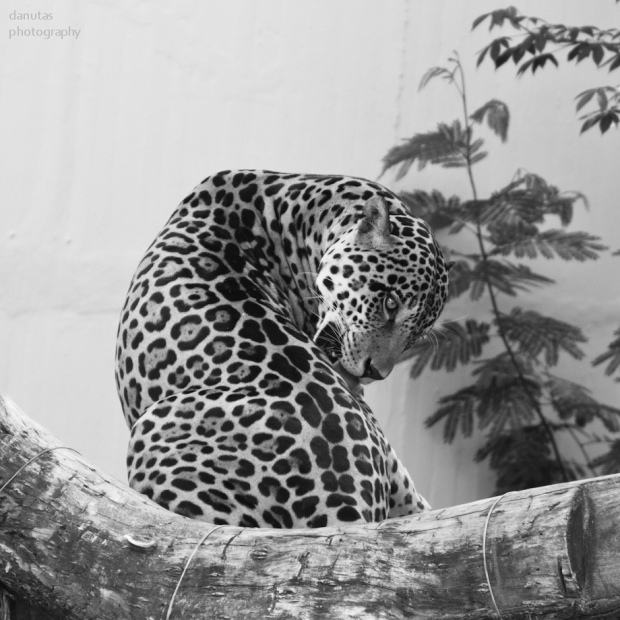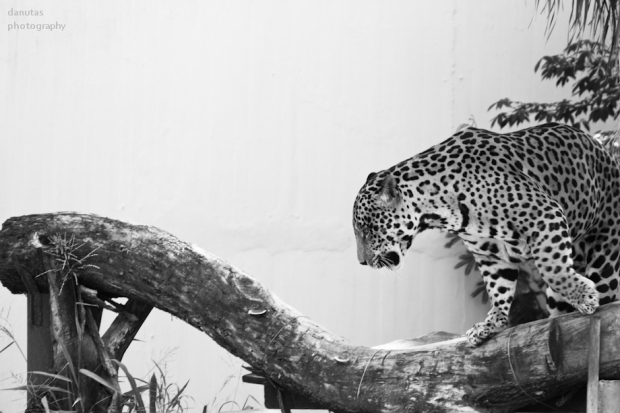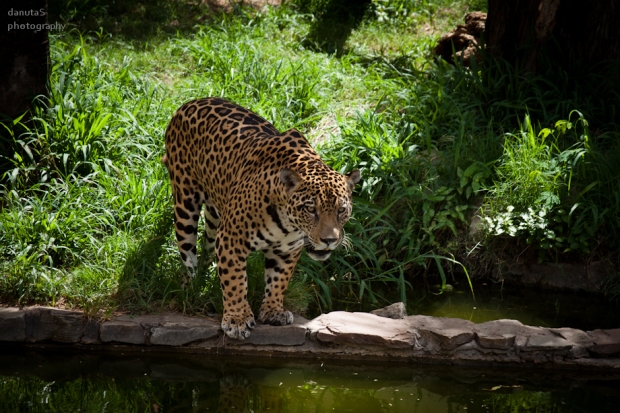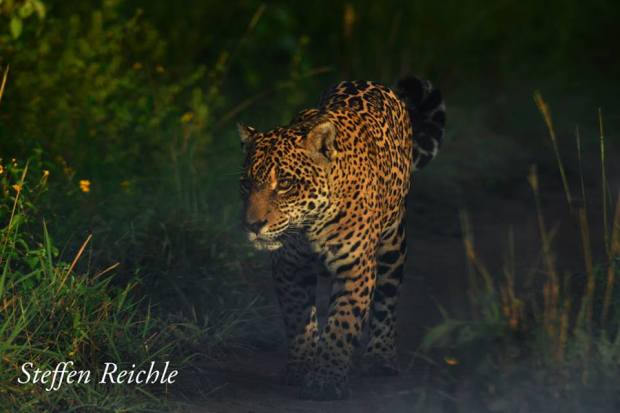Podczas naszej ostatniej wizyty w zoo doszlismy do wniosku, iz placowka ta z roku na rok, z miesiaca na miesiac ma sie coraz gorzej. Dlaczego? Coz, sytuacja zwierzat moze nie ulegla zmianie (poprawie) – wiekszosc z nich wciaz przebywa w malych klatkach, ale caly teren zoo wydaje sie byc placem budowy, tylko nie wiadomo co sie buduje. Juz nie chodzi tylko o dziury w chodnikach, ale takze gruz i metalowe prety ulozone lub porzucone wzdluz sciezek i przy placach zabaw. Widac tez nowe inwestycje, jak budynek akwarium, jednakze tak szybko jak sie tam wejdzie, chce sie z niego uciec – a wszystko to za sprawa braku wentylacji oraz kontroli ilosci zwiedzajacych ten malutki przybytek.
Przeczytalam ostatnio, ze zoo miejskie zmaga sie z brakiem funduszy na renowacje, a oplaty za wstep ledwo pokrywaja zakup pozywienia dla zwierzat. Moze to i prawda, ale dlaczego wiec nie podniesie sie cen, ktore od lat sa takie same? Smiesznie niskie, nawet na boliwijskie standardy – 10 Bs. dorosli, 5 bs. dzieci. Zdumiewa mnie to tym bardziej, ze w koncu zoo miesci sie w najbogatszym miscie w Boliwii, gdzie 10 Bs. starcza na duza wode mineralna lub butelke Coca-Coli. Z cala pewnoscia ludzi byloby stac na bilety za 20 – 30 Bs., a ‘odnowione’ i zadbane zoo przyciagnelo by jeszcze wiecej zwiedzajacych.
Z poprawy warunkow bytowania z cala pewnoscia ucieszylyby sie miedzy innymi ‘wielkie koty’, z ktorych wiekszosc upchana jest dzis na malutkich cementowych wybiegach, odgrodzonych od drogi szybkiego ruchu jedynie metalowa siatka. Zestresowane kraza w te i we wte, wokol swoich klitek.
Tylko dla jednego z jaguarow przygotowano wiekszy, porosniety trawa, i odgrodzony od widzow fosa, wybieg. Daje on mozliwosc obserwowania tego majestetycznego zwierzecia, z zachowaniem wszelkiej ostroznosci, a jaguarowi zapewnia minimum kontaktu z rozwrzeszczanym tlumem oraz prywatnosci.
Przyznam, jest to jedno z moich ulubionych miejsc w zoo, wlasnie z uwagi na wyzej wymienione punkty. Kolejnym plusem jest zas mozliwosc fotografowania tego pieknego stworzenia.
Ponizej przedstawiam garsc zdjec z naszej ostatniej wyprawy do zoo oraz kilka faktow o tym jednym z najwiekszych kotow na swiecie.
Jaguar jest jedynym przedstawicielem rodzaju Panthera żyjącym w Nowym Świecie. DNA wskazuje, że jaguar, lew, tygrys, lampart, irbis i pantera mglista dzielą wspólnego przodka sprzed 6 do 10 milionow lat.
Chociaz ten cętkowany kot fizycznie najbardziej przypomina lamparta, zazwyczaj jest wiekszy i ma mocniejszą budowe, natomiast jego zachowanie upodabnia go bardziej do tygrysa. Preferuje on gesty las deszczowy, ale zamieszkuje takze inne siedliska – otwarte jak i porosłe drzewami. Jest silnie związany z obecnoscią wody i, podobnie jak tygrys, uwielbia pływac.
Słowo „jaguar” pojawilo się w jezyku angielskim dzięki amazonskim językom tupi-guarani, gdzie słowo yaguara oznacza bestie, czasami zas tłumaczy się je jako „pies”.
Gatunek cechuje zmiennosc ubarwienia. Regularnie spotyka się okazy melanistyczne, jednak choc jaguar taki wydaje się zupełnie czarny, z bliska mozna dojrzec jego cetki. Czarnego jaguara nazywa sie potocznie ‘czarna pantera’. Albinosy sa ekstremalnie rzadkie.
Typowa długosc zycia jaguara na wolnosci szacowana jest na 12 do 15 lat, ale w niewoli dozywa on 23 lat.
Jak wiekszosc kotowatych, jaguar zyje samotnie, i jak inne wielkie koty, potrafi ryczec (ryk jaguara podobno przywodzi na myśl powtarzające się kaszlnięcia). Zwierze potrafi tez miauczec i mruczec.
W prekolumbijskiej Ameryce Srodkowej i Południowej jaguar stanowil symbol sily i mocy. Posrod kultur andyjskich kult jaguara rozszerzyl sie dzięki wczesnej kulturze Chavín (słowo chavin w lokalnych dialektach oznacza wlasnie jaguara).
W Boliwii kult jaguara (i pumy: kota andyjskiego?) ‘zapisany’ zostal na antycznej ceramice, malowidlach i rytach naskalnych przez kultury takie jak Huari, Tiwanaku, Chane (El Fuerte of Samaipata) i Inka.
Inkowie uważali jaguara (pume) za swoje „swiete zwierze” wraz z wezem i kondorem. Waz symbolizował swiat podziemia, puma swiat ludzi, a kondor – ptak zywiący sie padlina – był straznikiem miejsc swiętych oraz ludzi umarlych. Waz był pierwszym etapem człowieka, sila napedowa, ktora idzie wzdłuz kręgosłupa. Puma z kolei uczyła stabilnosci, praktyki duchowej i doprowadzała do najwyzszego szczebla – kondora, bedacego uosobieniem boskosci, lacznikiem miedzy swiatem bogow i ludzi.
Niestety w ostatnich latach populacja jaguarow drastycznie zmniejsza swa liczebnosc, a International Union for Conservation of Nature and Natural Resources przyznal mu status gatunku bliskiego zagrozenia.
Największe ryzyko dla jaguarow stanowia wylesianie ich siedlisk, wzrastająca konkurencja o pokarm ze strony ludzkiej, kłusownictwo oraz zachowania ranczerow, ktorzy czesto zabijają duze koty polujace na zwierzęta hodowlane.
Miedzynarodowy handel jaguarem badz czesciami jego ciala został zakazany. Wszelakie polowania na te zwierzęta sa zabronione w Argentynie, Belize, Kolumbii, Gujanie Francuskiej, Hondurasie, Nikaragui, Panamie, Paragwaju, Urugwaju, Wenezueli, Surinamie i Stanach Zjednoczonych, gdzie obejmuje go ‘Endangered Species Act‘.
Gatunkowi nie przysługuje jednak ochrona prawna w Ekwadorze i Gujanie, a polowania na osobniki wywolujace problemy dopuszczone sa w Brazylii, Kostaryce, Gwatemali, Meksyku i Peru.
Niestety, w Boliwii dozwolone jest wciaz myslistwo rekreacyjne…
Zrodla: Wikipedia, Cocha Banner Magazine, miktravel.com.
Zdjecia: ZOOLOGICO MUNICIPAL FAUNA SUDAMERICANA Santa Cruz de la Sierra ——> (Zoo w Santa Cruz de la Sierra, Nandu, Z wizyta u wyjca amazonskiego, Z wizyta w Nowym Jorku).
Zapraszam rowniez do odwiedzenia galerii fotografa, biologa i konserwatora przyrody Steffena Reichle, mieszkajacego w Boliwii, ktoremu juz kilkakrotnie udalo sie sfotografowac jaguary na wolnosci, w ich naturalnym srodowisku —-> Steffen Reichle Photography.
***
During our last visit to the zoo we came to the conclusion, that Santa Cruz’s facility from year to year gets only worse. Why? Well, the situation of animals hasn’t changed (improved) – most of them still live in small cages, but the whole area of the zoo seems to be like a building site, only no one knows what is being built. It’s not just about holes in the pavement, but also debris and metal rods stacked or abandoned along the paths and playgrounds. There is a new investment, the building of an aquarium, however as soon as you go in you want to go out – all this for the lack of ventilation and control over the amount of visitors storming this tiny place.
I read recently that the city zoo is struggling with a lack of funds for renovations, and that the admission fee barely covers the purchase of food for the animals. Maybe it’s true, but then I ask why don’t they rise the price of the tickets, which have been the same over the years? Ridiculously low, even for Bolivian standards – 10 Bs. adults , 5 bs. children. It amazes me even more, as the zoo is located in the richest city of Bolivia, where 10 Bs. buys you a bottle of Coca -Cola. Certainly, people here could afford a ticket for 20 Bs., and a ‘refurbished’ and neat zoo would have attracted even more visitors.
The improvement of living conditions for sure would also have made happy the ‘big cats’, today crammed in tiny cemented cages, fenced off from the highway only by metal net. Stressed, they circulate all the time around their enclosures.
Only one of the jaguars ‘enjoys’ larger run, covered with grass and separated from the spectators with the moat, which gives a great opportunity to observe this majestic animal, with all precautions. It also provides the jaguar with a minimum contact with a crying crowd and some privacy. I admit, this is one of my favorite places in the zoo, just because of the reasons mentioned above. Another advantage of that setting is the possibility of photographing this beautiful creature without any obstacles.
Therefore, above I present a handful of photos from our last trip to the zoo and below few facts about one of the biggest cats in the world.
- Jaguar is the only representative of the genus ‘Panthera’ in the New World. DNA evidence shows that lion, tiger, leopard, jaguar, snow leopard and clouded leopard share a common ancestor, and that this group is between six and ten million years old.
- This spotted cat physically most closely resembles the leopard, although it is usually larger and sturdier, and its behavioral and habitat characteristics are closer to those of the tiger. Jaguar prefers rainforest, but also settles in the variety of forested and open terrains. It is strongly associated with the presence of water and similar to tiger, jaguar enjoys swimming.
- The word “jaguar” appeared in the English language through Amazon Tupi – Guarani language, where the word yaguara means “beast”, sometimes being translated as “dog”.
- Color morphism occurs in the species quite often. Jaguars with melanism (6%) appear entirely black, although their spots are still visible on close examination. They are informally known as black panthers. Albinos are extremely rare.
- The typical life expectancy of a jaguar in the wild is estimated between 12 and 15 years, but in captivity jaguar can live up to 23 years.
- Like most felines, the jaguar lives alone, and as the other big cats is able to roar (which often resembles a repetitive cough). It may also vocalize mews and grunts.
- In pre-Columbian Central and South America, jaguar was a symbol of strength and power. Among the Andean region, a jaguar cult expanded through the early Chavín culture (‘Chavin’ in local dialect means jaguar).
- In Bolivia, a jaguar (and puma) cult is visible on ancient ceramics, paintings and rock carvings by cultures of Huari, Tiwanaku, Chane (—>El Fuerte of Samaipata) and Inkas.
The Incas considered jaguar (puma) their “sacred animal” together with the snake and condor. Snake symbolized the underground world, puma world of people, and condor – bird feeding on carrion – a guardian of the sacred places and dead people. Snake was the first stage of human driving force, which goes along the spine. Puma, taught stability, spiritual practice, and drove to the tallest level – the bird. Condor was the personification of the divine, a connection between the world of gods and men.
- Jaguar populations are rapidly declining. The animal is considered Near Threatened by the International Union for Conservation of Nature and Natural Resources, meaning it may be threatened with extinction in the near future.
The major risks to the jaguar include deforestation across its habitat, increasing competition for food with people, poaching and the behavior of ranchers who will often kill the cat where it preys on livestock.
Any international trade in jaguars or their parts is prohibited. Hunting of jaguars is prohibited in Argentina, Belize, Colombia, French Guiana, Honduras, Nicaragua, Panama, Paraguay, Suriname, the United States (where it is listed as endangered under the Endangered Species Act), Uruguay and Venezuela.
The species has no legal protection in Ecuador or Guyana. Hunting of jaguars is restricted to “problem animals” in Brazil, Costa Rica, Guatemala, Mexico and Peru. Trophy hunting is still permitted in Bolivia…
Sources : Wikipedia, Cocha Banner Magazine, miktravel.com.
Photos: Zoologico Municipal Fauna Sudamericana Santa Cruz de la Sierra (–> For People Only, Nandu, New World Monkey, Visiting New York).
I invite you also to visit the gallery of photographer, biologist and nature conservation specialist Steffen Reichle based in Bolivia, who repeatedly managed to ‘capture’ the jaguar (and other wild animals) in its natural environment —-> Steffen Reichle Photography. Where they really should be.








What a beautiful animal. It is sad to think of his mates in tiny cages, but thank you for sharing these stunning photos. Nothing at all like a jaguar in Australia.
LikeLike
Thank you Mandy, I must say, these are stunning creatures, but I think I wouldn’t like meeting them face to face:) Is that a true, there are black panthers in Australia: http://www.australianbigcats.com/p/the-australian-bush-holds-many-secrets.html?
LikeLike
You’ve stumbled upon one of Australia’s most controversial topics – our legendary black panther. For years there have been stories and suspected sightings of the panther, but no concrete evidence has ever been produced. Our little village was actually where the first panther “hysteria” began in 1953 – keep an eye on my blog – I hope to write about it this year.
LikeLike
I will! I love mysteries:)
LikeLike